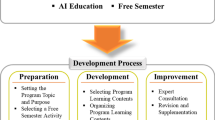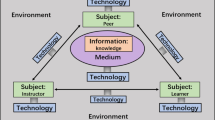Abstract
We developed a game based content for learning to minimize boolean functions using Karnaugh Map. With interesting game based scenarios and an intelligent tutoring module, our content could give adaptive feedbacks to learners as needed in order to make the learners well-motivated and immersed in learning context. We performed an experiment for three student groups (one experimental group and two control groups) which were learning the minimization of boolean functions at a vocational high school in Korea, and compared our content aided learning to other conventional ones for evaluating the learning effectiveness. In this experiment, we identified that our content aided learning was more effective than other ones significantly in terms of both academic achievement and learning attitude. More specifically, our content was very useful for learners to improve academic attitude and learning habit.








Similar content being viewed by others
Notes
This SCORM content package file is publicly accessible at “http://iislab.hanyang.ac.kr/SCORMContents/”, and also playable on “http://iislab.hanyang.ac.kr/moodle/mod/resource/view.php?inpopup=true&id=70”.
Karnaugh Minimizer is a “boolean function minimization” simulator which provides good visual representation for Karnaugh map, but it provides neither GBL nor IT functionalities.
“basics of boolean logic” is a prerequisite of “the minimization of boolean functions” in the track of “computer and information”.
References
Bersin J, Howard C, O’Leonard K, Mallon D (2009) Learning management systems. Bersin & Associates, Oakland
Black PE (2004) Gray code. NIST. http://xlinux.nist.gov/dads//HTML/graycode.html. Accessed on 23 December 2013
Burgos D, Moreno-Ger P, Sierra JL, Fernandez-Manjon B (2007) Authoring game-based adaptive units of learning with IMS Learning Design and e-Adventure. Int J LearnTech 3(3):252–268
Graesser AC, Chipman P, Leeming F, Biedenbach S (2009) In: Ritterfield U, Cody M, Vorderer P (eds) Deep learning and emotion in serious games. Serious Games: Mechanisms and Effects. Taylor, and Francis, Mahwah
Graesser AC, Jackson GT, McDaniel B (2007) AutoTutor holds conversations with learners that are responsive to their cognitive and emotional states. Educ Technol 47:19–22
Halverson R (2005) What can K-12 school leaders learn from video games and gaming? Innovate, 1(6)
IMS (2003) IMS learning design best practice and implementation guide. IMS Global Learning Consortium
Karnaugh (2013) Karnaugh Minimizer. http://karnaugh.shuriksoft.com/. Accessed on 25 July 2013
KEDI (1992) Developing educational evaluation system III. RM 92-05-02, Korea Educational Development Institute
Koedinger KR, Anderson JR, Hadley WH, Mark MA (1997) Intelligent tutoring goes to school in the big city. Int J Artif Intell Educ 8:30–43
LSAL (2004) SCORM best practices guide for content developers 1st edition. Learning Systems Architecture Laboratory, Carnegie Mellon University, Pittsburgh
Luk ETH, Wong MKH, Cheung KKF, Lee FL, Lee JHM (2006) Design and implementation of farmtasia: a game designed for the VISOLE teaching style. In: 1st International Conference on Technologies for e-Learning and Digital Entertainment
Manske M, Conati C (2005) Modelling learning in educational games. In: 12th International Conference on AI in Education, Amsterdam
McCluskey EJ (1986) Logic design principles : with emphasis on testable semicustom circuits. Prentice-Hall, Englewood
Mills C, Dalgarno B (2007) A Conceptual model for game based intelligent tutoring systems. Proceedings of ascilite, Singapore
Mitrovic A, Suraweera P, Martin B, Weerasinghe A (2004) DB-suite: experiences with three intelligent web-based database tutors. J Interact Learn Res 15:409–432
Mohammed P, Mohan P (2007) Sugar coated learning: Incorporating intelligence into principled learning games. Proceedings of Learning with Games, Sophia Antipolis, France
Moreno R, Mayer RE (2005) Role of guidance, reflection, and interactivity in an agent-based multimedia game. J Educ Psychol 97:117–128
Ong J, Ramachandram S (2003) Intelligent tutoring systems: using AI to improve training performance and ROI. Stottler Henke Associates Inc., California
Piskurich GM (2006) Rapid instructional design: learning ID fast and right 2nd edition. John Wiley & Sons Inc, San Francisco
Riad AM, El-Minir HK, El-Ghareeb HA (2009) Review of e-learning systems convergence from traditional systems to services based adaptive and intelligent systems. Journal of Convergence Information Technology, 4(2):108–131
Schmmel BJ (1983) A meta-analysis of feedback to learns in computerized and programmed instruction. American Educational Research Association, 67
Shang J, Jong MSY, Lee FL, Lee JHM (2007) A Pilot study on virtual interactive student-oriented learning environment. In: 1st IEEE International Workshop on Digital Game and Intelligent Toy Enhanced Learning
Tan J, Biswas G (2007) Simulation-based game learning environments: building and sustaining a fish tank. In: 1st IEEE International Workshop on Digital Game and Intelligent Toy Enhanced Learning
Van Eck R (2007) In: Gibson D, Aldrich C, Prensky M (eds) Building intelligent learning games. Games and Simulationss in Online Learning Research & Development frameworks. Idea Group, Hershey
Van Lehn K, Graesser AC, Jackson GT, Jordan P, Olney A, Rose CP (2007) When are tutorial dialogues more effective than reading? Cogn SciJ 31:3–62
Ward N (2007) IMS common cartridge. IDA Lab
Zhou Y, Evens MW (1999) A practical student model in an intelligent tutoring system. In: 11th IEEE International Conference on Tools with Artificial Intelligence
Acknowledgments
The author would like to give special thanks to his research assistant, Hee Jung Yu for performing some parts of experiments. His efforts considerably contributed to building timely completion of this paper. This work was supported by the research fund of Hanyang University (HY-2013). This research was supported by the MSIP, Korea, under the ITRC support program (NIPA-2013- H0301-13-1001) supervised by the NIPA, and the National Research Foundation of Korea (NRF) grant funded by the Korea government (MSIP) (No. 2013026290).
Author information
Authors and Affiliations
Corresponding author
Rights and permissions
About this article
Cite this article
Choi, Y.S. Effectiveness of game based learning to minimize boolean functions. Multimed Tools Appl 74, 7131–7146 (2015). https://doi.org/10.1007/s11042-014-1956-8
Published:
Issue Date:
DOI: https://doi.org/10.1007/s11042-014-1956-8




